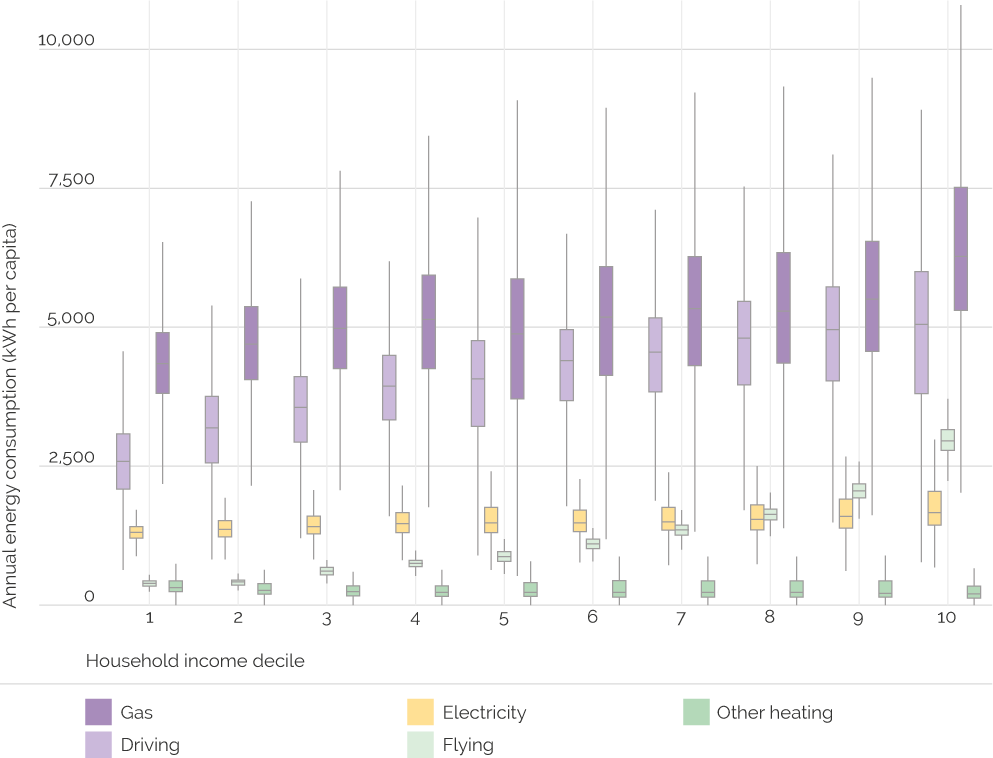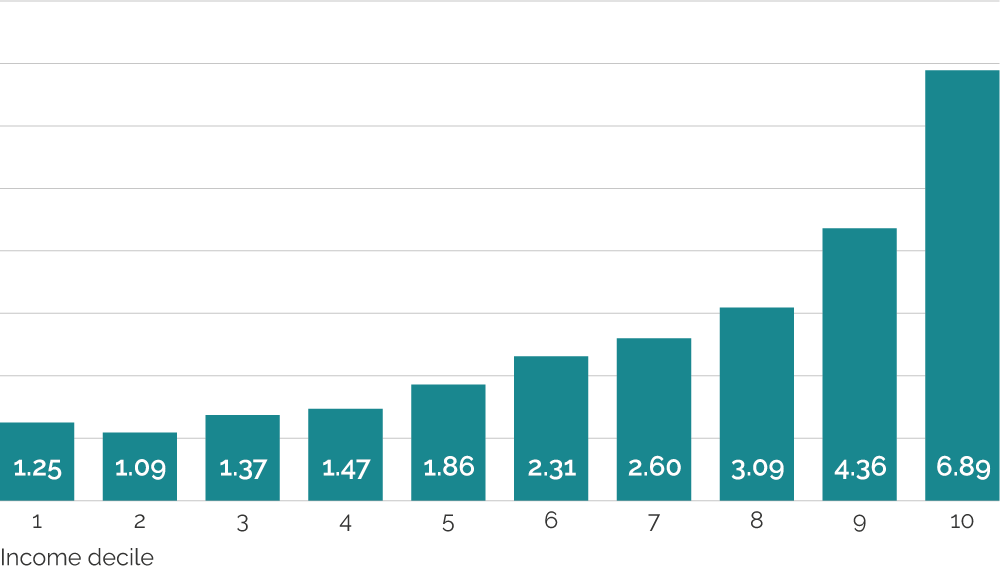In this blog, Noel Cass argues that the decisions people make are determined by infrastructure – yet the government still treats these systemic determinants as if they are simply matters of consumer choice.
How households use energy varies from always-on appliances through heating, cooking, and driving, to big-hit carbon guzzlers like long haul holiday flights. And not everyone does the same. But policy tends to expect those who can’t afford to pay, and those who can’t change much about what they do, to pay for green policies through their energy bills. How can excess household energy consumption be targeted fairly?
Around 72 per cent of our carbon emissions arise from how we live our lives. Since at least 1998 the official line on climate action has been that “all sections of society down to the individual are ‘responsible for taking decisions on a daily basis that will dictate the success of the climate change strategy’.”
For over 20 years, government policy has largely relied on behaviour change to reduce household energy consumption. Essentially this has meant trying to convince people to buy different things and make smarter choices. But rising emissions over the past two decades tell us this strategy clearly isn’t working.
At CREDS, through our Curbing Excess research, we have been looking at what household energy consumption is made up of and how it is distributed across society. We’ve tested ideas to see how our energy use might be fairly, acceptably and effectively tackled through different policy approaches, beyond simply relying on behaviour change.
The main areas of household energy use are summarised below. Home heating using gas and car use are prominent, followed by electricity, with flying being responsible for more emissions per capita than electricity in the wealthiest 30 per cent of households.
Annual energy consumption of different income groups

Image description
Box and whisker plots show the annual amount of energy consumed per capita by different activities and in different household income groups. The amount of electricity used only increases slightly between the 10 income groups, averaging around 1250 kWh per capita. Other heating also remains fairly steady, averaging around 250 kWh per person. Energy consumption of flights increases notably the higher household income is, ranging from around 300 kWh per person in decile 1 to over 2,500 kWh in decile 10. Driving consumes a great deal of energy and also increases with household income – from an average of around 2,500 kWh per person in decile 1 to over 5,000 kWh in decile 10. Most energy is used for gas, largely heating, with an average of around 4,000 kWh per person in decile 1, increasing to an average of over 6,000 kWh per person per year in decile 10.
This graph also demonstrates that there are ‘baseline’ levels of gas and electricity use that do not vary much between different levels of income, meaning the lowest income groups are hit especially hard by rocketing prices. Climate policies should protect those for whom this baseline cost is a significant proportion of their income: that is why broader carbon taxes and income tax are fairer methods for ‘environmental levies’ than the current surcharges on bills. A fairer way still to fund green policies is to use carbon taxes that are compensated by universal green vouchers for free renewable electricity and public transport. This would achieve higher emission reductions and reduce energy poverty while expanding, and giving fair access to, these goods and services.
Twice as much energy is used for car travel, on average, in the richest households as in the poorest, but some poorer households are car dependent or living in transport poverty. Mileage allowances and exponentially rising ‘frequent driver’ charges could be used to fairly discourage excess car use, without penalising those who really need to drive.
Finally, flying is not only the most climate damaging single behaviour, it is also the most unequally distributed, both globally (one per cent of the population are responsible for 50 per cent of flying emissions) and nationally (15 per cent of air passengers take 70 per cent of commercial flights). This distribution correlates with wealth too, as shown in the graph below.
Average number of flights per year in England

Image description
People in the first income decile took an average of 1.25 flights per year; in the second, 1.09 flights; in the third, 1.37 flights; in the fourth, 1.47 flights; in the fifth, 1.86 flights; in the sixth, 2.31 flights; in the seventh, 2.6 flights; in the eighth, 3.09; in the ninth, 4.36; and in the tenth decile, 6.89 flights.
The decisions people make are determined by infrastructure
All these policies make sense in terms of ‘climate justice’; i.e. by targeting the excess consumption of the wealthy and not penalising the necessary consumption of those on lower incomes. Flights and leisure driving, and possibly some electricity use, might be seen as daily decisions over which individuals genuinely have some degree of choice and, therefore, as fair targets of pricing policies. But, for many, decisions around home heating, commuting and school runs are determined by infrastructure: the fabric of houses and gas central heating, the allocation of road space and the lack of adequate public transport. Yet the government still treats these systemic determinants as if they are simply matters of consumer choice.
On driving, the government states that making it cheaper would increase congestion, but it also insists, on principle, that road pricing should not increase the cost of driving. It states that the cost of electrifying heating is £250 billion and says that convincing households to spend £10,000+ each is “a challenge”. Although strong government policy is needed – to invest in low carbon technologies, ban high carbon options and price energy inefficiencies out of the market – instead, the first principle of the UK’s net zero strategy is to “go with the grain of consumer choice”.
Opinion polls frequently find that the majority are calling for stronger government action and policies, including bringing forward net zero deadlines. However they also find that people are unwilling to change their habits. This is because the required action is not behaviour change but systemic change which shapes the choices consumers can make.
When people are given time and space to weigh up climate policy options, they consistently focus on government policies that reflect a nationalisation, regulation, market-limiting agenda, which is only sometimes revealed by surveys.
Our own deliberative workshop participants confirmed these findings with, for example, support for massive investment in public transport, renewables and insulation, rationing of car mileage and flights, exponential frequent flier levies and road pricing, especially urban congestion charges.
An informed public understands that responsibility for tackling their emissions lies first, and mostly, with the government.
This blog was first published on Green Alliance.
Banner photo credit: Jon Tyson on Unsplash



